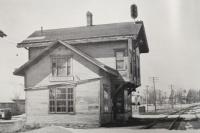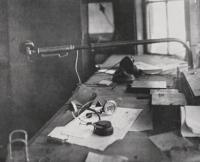
Serving the Vermont Champlain Valley Area for 45 Years
Main SectionsFront Page SportsValley VitalsIt's in the StarsStarwiseArchivesLinksAbout The VoiceContact Us |
Hearing The Whistle Blow - Trains History And Historian Ron NimblettTuesday February 23, 2010 By Cookie Steponaitis The sound of a train whistle means one thing to most Vermonters, having to stop at the railroad crossing and wait until the train goes by. Some of us wave to the engineer but most of us look for the caboose signaling the end of the train. Then we go about out day, with little or no thought being given to the train we saw or the role of the railroad in our country or town. However, that is not the case when it comes to train enthusiast Ron Nimblett who taught Social Studies at VUHS from 1987 to 2006. Every student of his knew when the train whistle blew, class stopped and the group went to the window to get a glimpse of the train and to hear a piece of history from their teacher. Spending time with Ron Nimblett is to see first hand how passionate he is about this form of transportation, its role both today and in the past in American history. Vermont’s oldest train station is located in Vergennes, Vermont, behind the Building Supply and Champlain Discount. The first question asked of Mr. Nimblett was why is the Vergennes depot on the outskirts of town? Mr. Nimblett explained, “That in the 1800’s towns wanted to have the trains. For most towns, the depot was located in the heart of the city, closest to all the means of production. In the case of Vergennes, most of the commerce and business was located on the falls of the Otter Creek and materials were moved out to the lake on steamships. The town fathers did not think that trains would be a long term part of life, so they decided to rely on the steamships and the existing transportation system they had. So, the railroad company replied by coming to Vergennes and building the depot and tracks on the outskirts of the town.” Walking around the outside of the depot today it is not hard to imagine the voices and footsteps of the thousands of passengers and workers who moved through the doors of the station, on their way to destinations beyond Vermont’s borders. It is apparent by looking at the station that there were two entrances. When queried about this, Mr. Nimblett remarked, “In 1849, the Rutland & Burlington Railroad (later renamed the Rutland Railroad) built the line through Vergennes on the way to Burlington. At the same time, they also built a passenger station and freight house which still stand today. The station is the oldest wooden railroad station in Vermont and has segregated waiting rooms; one for women and children and the other one for men and smokers.” While history has recorded the visits of U.S. Presidents to Vergennes on two separate occasions, probably the most famous passenger that stopped at the Vergennes depot and continued his journey to the Steven’s House and then to the ferry to New York was the famous Civil War Abolitionist John Brown. Mr. Nimblett shared, “Probably the biggest event in the station's history concerned the abolitionist movement prior to the Civil War. Abolitionist John Brown lived in North Elba, New York and moved around the country and territories spreading the news that action was needed in order to rid the United States of slavery. At that time, there were few trains in the New York North Country and for Brown the closest station was in Vergennes, Vermont. He made many departures from the Vergennes station on his quest but his last departure was the precursor to the Civil War. It was then in 1859 that Brown, two of his sons, and other followers boarded the train in Vergennes and left to start a slave rebellion at Harpers Ferry, Virginia (now West Virginia). The Federal Government put down the rebellion, captured Brown, tried him in court and hanged him. His body was brought back by train and returned to Vergennes with his wife. From the station, his body was transported to Adams Ferry for the trip across Lake Champlain and arrived in Westport, New York and by wagon onward to North Elba.” As with all things, change did come to the Vergennes depot and one year after the railroad came to the city the town leaders agreed to have a railroad spur built. It came 1.5 miles to the downtown and a bridge was built to have it cross the Otter Creek. The train track ended at the site of the Monkton Iron Works and then turned around coming back through and out of town. A covered bridge crossed the Otter Creek and there was a small passenger station there along with the warehouses. A storm actually destroyed the covered bridge and with the end of the Civil War in 1865, the spur line was abandoned and dismantled. In a time where the nation is looking at upgrading its train system and modernizing the structure used to still move staggering amounts of cargo annually, there is hope that the train whistle will be blowing more in the near future. Diehard enthusiasts like Ron Nimblett often spend part of their summer working on the trains and providing guided tours to groups of interested passengers. The train is more than a way to get across the country for Ron and fellow enthusiasts. It represents freedom and a link to our heritage. It is part of who we are as a nation. It calls to people to ride and see how America looks by rail. So many times on our travels, the destination is the focus and the journey is let go. Mr. Nimblett remarked on his own passion for trains, “I became interested in trains and railroading like most kids in the1950's; a Lionel Electric Train. Today half of my basement is a model Lionel layout that I've been working on for fourteen years and I hope never to finish it. I'm a member and past president of the Champlain Chapter of the National Railway Historical Society.” The next time you are stopped at the tracks as the train passes, do more than talk on your cell phone or plan your grocery list. Look, really look at the train in front of you. Imagine where it started? Where it is going? How much country has it seen? What cargo is it carrying? What does our country and our state owe to the railroads? Then and only then; when the whistle blows will we do more than stop our vehicles and wait impatiently for the train to pass.
|
AdvertisementsSearch our Archives |
Agricultural Weather Forecast:

© 2006-18 The Valley Voice • 656 Exchange St., Middlebury, VT 05753 • 802-388-6366 • 802-388-6368 (fax)
Valleywides: [email protected] • Classifieds: [email protected] • Info: [email protected]


 Printer Friendly
Printer Friendly